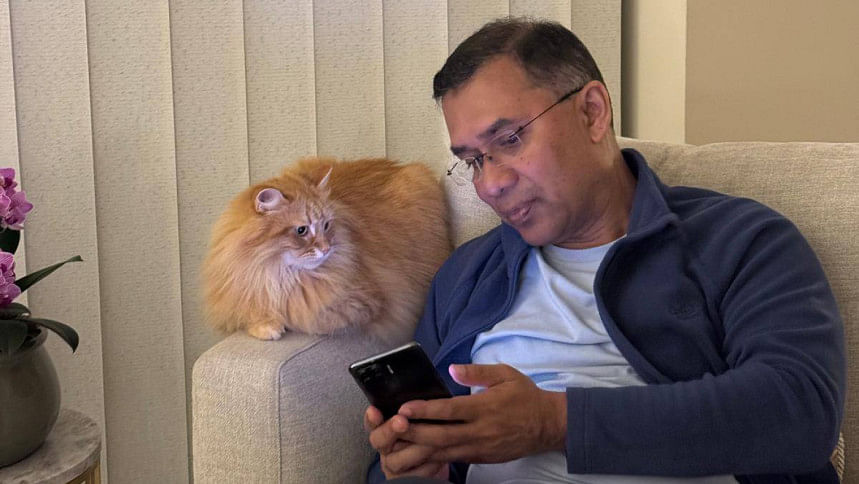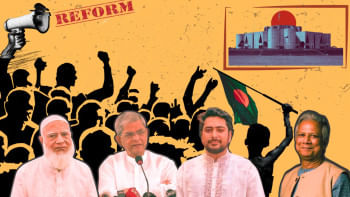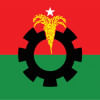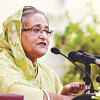In the company of a cat

Sometimes a photograph does more than capture a moment. It reshapes how we think about presence, power, and leadership. It does not explain, it does not argue, but it lingers, working on us in ways we may not immediately register. That seems to be the case with the recent image of Tarique Rahman, the acting chairman of Bangladesh Nationalist Party (BNP), who has remained in exile since 2008, seated quietly with a cat. The photo circulated widely on social media. Viewers responded with curiosity, warmth, and even admiration. But its significance lies less in surface charm than in what it allows us, or perhaps invites us, to imagine.
In Bangladesh's political culture, leadership is often marked by confrontation. Visibility tends to mean protest, and legitimacy is typically demonstrated through rhetorical force. Authority is asserted through volume, repetition, and spectacle. A quiet image like this disrupts that familiar rhythm. There is no urgency, no slogan, no posturing. Instead, we see stillness and ease. A scene that, at first glance, appears apolitical begins to suggest something else: that leadership can project confidence through composure rather than command.
In Media and the Restyling of Politics: Consumerism, Celebrity and Cynicism, political theorists have noted this shift as part of a broader transformation in how leadership is performed. Symbolic gestures often carry more weight than speeches in an age shaped by digital media. People respond less to manifestos and more to emotional tone—to the atmosphere a figure creates, and the impression of steadiness or imbalance they leave behind. Presence now depends as much on how a leader makes people feel about themselves as on what they formally say or do. In that sense, what might seem like a fleeting moment of domestic stillness is, in another light, a calculated shift in tone. The image reframes the political figure not through assertion or debate, but through atmosphere, inviting viewers to imagine a softer, more composed side of leadership.
Of course, performance and sincerity are not opposites. Not all performance is manipulative, and not all sincerity is unfiltered. However it came to circulate, the image now functions as more than a snapshot. It reflects intention, reveals personality, and resonates with broader meaning. In politics, as in art, the line between the posed and the real is rarely fixed.
Among younger citizens, particularly those fatigued by the formal language of party politics, such a gesture may resonate more than a manifesto. It does not demand allegiance or approval. It simply appears, allowing space for quieter forms of connection to take root. In a climate often defined by exhaustion and mistrust, even that suggestion can carry emotional weight.
The presence of the cat introduces a quiet contrast to the usual political image. It does not pose or perform. It simply stays close, at ease. In doing so, it helps shape the emotional tone of the scene. Cats are not easily coaxed into comfort. They respond to trust, not command. The fact that it sits calmly beside the political figure adds a layer of familiarity to the image, hinting at a kind of unspoken equilibrium between figure and animal. It gestures toward stability, but does so in silence.
Yet, images do not circulate in isolation. They enter political landscapes already shaped by memory, uncertainty, and the accumulation of unanswered questions. And this particular image, for all its charm, arrives under the shadow of a prolonged and unaddressed absence.
Tarique Rahman is no longer under legal sanction. The courts have cleared the way for his return. Yet, he remains outside the country. His online presence has grown more active. His digital persona seems more carefully managed. But his physical absence is no longer a side note. It has become central to how both allies and critics understand his political identity.
Political theory reminds us that presence is not only physical; it is also ethical. To be present is to stand within the same space as those one claims to represent. It is to share their risks, frustrations, and hopes. Legitimacy comes not only from consent, but from visible accountability.
The reason behind Tarique's absence from the country remains unclear. Some point to strategic caution, others to unresolved tensions within the party. Some refer to informal pressures that operate outside the law. Still others speculate about personal or family considerations. All may carry some truth. But politics does not wait for resolution. In the silence, interpretations emerge, and they harden into public perception.
This context matters even more now. Tarique Rahman increasingly speaks of reform, restructuring, and renewal. His recent statements suggest a new political tone, possibly even a new direction. To some, this may signal growth, a departure from earlier modes of rhetoric. But these reflections, however genuine, are still voiced from afar. And distance inevitably dilutes conviction. If these words were spoken from within the country, and if they were followed by action, they would be heard differently. They would carry not just the idea of reform, but the burden of responsibility.
We live in a time where symbolic gestures can carry great political power. But symbols cannot bear the full weight of public trust. Emotional resonance matters, but it must be matched by embodied presence and real decisions.
The cat may sit calmly. The photo may soften perception. But presence, if it is to have meaning, must become more than an image. It must take form in a shared political reality.
And in politics, the questions that go unanswered do not vanish. They gather force. Like a tiger crouching in the tall grass, they wait.
Kazi ASM Nurul Huda is associate professor of philosophy at the University of Dhaka. He can be reached at [email protected].
Views expressed in this article are the author's own.
Follow The Daily Star Opinion on Facebook for the latest opinions, commentaries, and analyses by experts and professionals. To contribute your article or letter to The Daily Star Opinion, see our guidelines for submission.

 For all latest news, follow The Daily Star's Google News channel.
For all latest news, follow The Daily Star's Google News channel. 










Comments